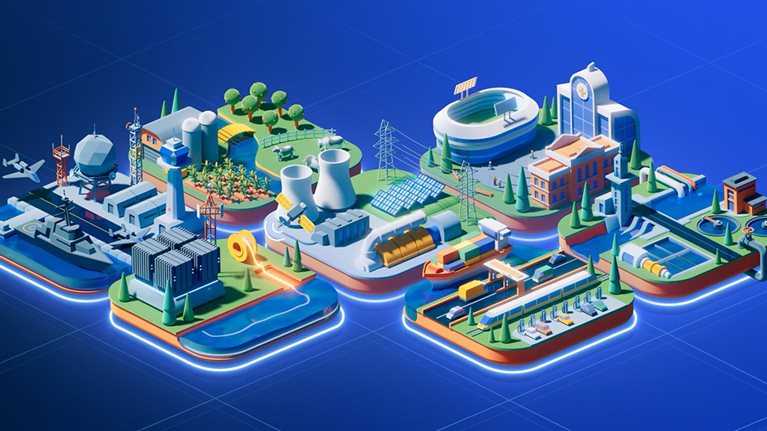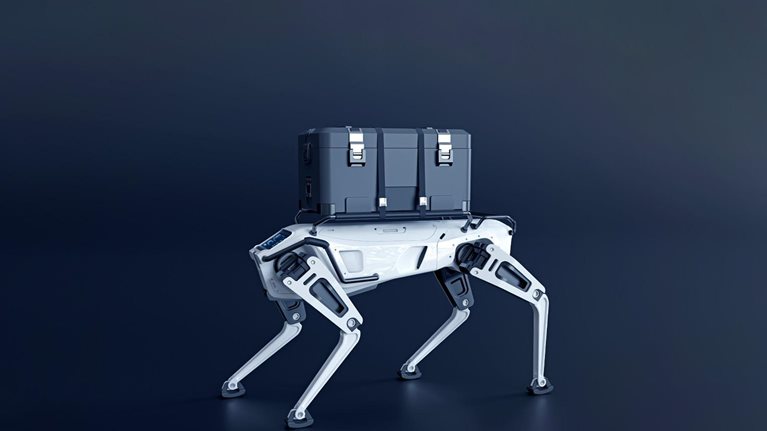For decades, the construction industry has wrestled with both rising demand and shrinking labor capacity. Productivity has stagnated, and the situation could soon worsen: Many workers are nearing retirement, and fewer young people are entering the field because of safety concerns, uncertainty about future prospects, and the physical intensity of construction work. To alleviate the labor crunch, some businesses have already automated a few common activities, including bricklaying and concreting, using purpose-built robots. A logical next step might involve the use of general-purpose robots, which can perform diverse, unrelated tasks across multiple settings.
General-purpose robots could be useful in a range of construction activities, from moving heavy concrete blocks to welding and plumbing. Although these robots come in various forms, humanoids—those that resemble people in size and shape—attract the most attention. Humanoids are still relatively early in development, but they could potentially transform industries if developers and other stakeholders can overcome technological, regulatory, financial, and operational hurdles.
Within construction, large-scale humanoid usage may be a decade away, partly because these robots still have difficulty navigating busy, unstructured worksites. But construction leaders should begin preparing for humanoid deployment now, because recent technological advances suggest the possibility of an accelerated timeline. The priority for business leaders should be to create a future workplace where humanoids are deployed to support workers, rather than replace them—creating a win for managers juggling multiple priorities, overburdened frontline staff, and customers who want projects completed more quickly.
The construction dilemma
Although construction technology has significantly advanced over the past two decades, construction industry productivity had a CAGR of only 0.4 percent between 2000 and 20221—far lower than that of other industries such as manufacturing, which had a 3.0 percent CAGR over the same period (Exhibit 1). Most growth in construction productivity resulted from activity in emerging markets.

Construction companies have achieved some productivity gains by applying digital tools, including building information modeling and computer-aided design. Overall, however, the industry has been slower to digitize tasks compared with other sectors, keeping it more reliant on manual labor and minimizing efficiency gains. Hiring more workers has been difficult because of the labor shortage. Exacerbating the problem, global demand for housing and infrastructure is accelerating, driven by urbanization, population growth, and the need to replace or expand aging assets. Projected supply is predicted to fall short of demand by about $40 trillion.2
Automation in the construction sector has advanced even more slowly than digitization. Most applications of automation are not in job sites but in off-site manufacturing of precast and prefab elements, such as walls, floors, and beams. On-site automation is particularly difficult because each project is unique and constantly evolving, with changing workplace layouts, numerous machines and people in motion, and high safety risks. In addition, construction sites often have unreliable network connectivity and limited digital infrastructure.
A few companies have undertaken pilots involving simple, nonhumanoid robots that autonomously or semiautonomously perform a single task, such as rebar tying or placement, or ceiling drilling for mechanical, electrical, and plumbing systems. These solutions have not yet achieved large-scale deployment. By contrast, pilot programs in groundworks and roadworks have been more successful, particularly with highly specialized robots such as driverless pavers and autonomous rollers.
Great progress with room to grow
Although humanoids are not yet a fixture at construction sites, they represent a potentially transformative solution to the productivity crisis. Their power comes from embodied AI, a technology that enables real-time decision-making. Whereas specialized robots repetitively complete a single task in a structured environment, developers are striving to make humanoid robots more versatile and have recently made some important advances, although there is room for more growth (see sidebar, “Enablers for large-scale humanoid deployment”). The following research areas are particularly relevant to construction.
Increasingly sophisticated AI foundation models
Vision-language-action foundation models enable humanoids to interpret visual cues and follow spoken instructions, which greatly increases their utility. With further advances in AI models and sensor technology, humanoids might be able to master complex construction tasks. While human apprentices often spend years observing and practicing under supervision, humanoids could rapidly analyze millions of construction videos, instructions, and demonstrations to learn skills much faster. Developers need vast amounts of construction data to enable this capability.
Better mobility and dexterity
Developers have greatly enhanced humanoid mobility, but further advances are needed before these robots can expertly navigate unstructured workplaces such as construction sites. While humans rely on experience, observations, directions from colleagues, or maps to get around, humanoids navigate by processing extensive data about their surroundings, including input from sensors and other contextual information.
Many humanoid models can now handle unstructured tasks, such as lifting irregularly shaped objects. Additional improvements are still needed for more complex or delicate activities, such as operating small tools with human-level dexterity. Robots will become more valuable in construction when they become capable of climbing ladders and scaffolding or walking on uneven terrain.
Increased focus on safety and collaboration
Advances in sensors, perception models, and other technologies have reduced many of the risks associated with general-purpose robots—for example, preventing them from using excessive force. The next step will involve creating safety features that allow “fenceless” operations, in which humanoids move freely across an entire workplace, rather than being confined to specific areas. Developers are also striving to improve AI models so that humanoids can collaborate seamlessly with human workers and respond correctly to all voice commands.
Application of humanoids in construction
Investors are increasingly funneling money to the humanoid sector (see sidebar “More than $1 billion in humanoid investment”). Within construction, leaders will focus on applications in which humanoids clearly provide more value than autonomous or semiautonomous single-task robots. What’s more, humanoids will be deployed to support workers, rather than replace them.
The earliest humanoid deployments in construction
Across industries, the first humanoid pilot programs typically involve repetitive, moderately complex tasks in low-variability environments, such as mapped grocery aisles or staged interiors with identical layouts. Some encouraging early results have been reported in the construction space. For instance, researchers in Japan have created a humanoid that can independently install drywall, but it has not yet been widely tested.3
In coming years, humanoid construction deployments will likely continue to focus on a narrow set of simpler, repetitive tasks or moderately complex tasks in highly structured zones. Despite these restrictions, the division of labor between workers and humanoids could increase overall productivity, allowing companies to accelerate progress.
Consider how humanoids might assist carpenters in the near future. At the beginning of the day, humanoids might prepare tools and clean the targeted space, freeing the carpenters to concentrate on more advanced tasks or specialized work. Other simple tasks that humanoids could undertake on-site might include painting walls and unloading trucks.
Long-term humanoid applications: More versatile assistants doing more complex tasks
To determine what construction tasks humanoids could perform in ten or more years, we assessed activities based on the level of collaboration involved, ease of training, dexterity requirements, and the structure of the work environment. We then categorized use cases according to the degree of relative task feasibility (Exhibit 2).

In a new build, for instance, humanoids could potentially assist with tasks such as on-site casting for framing structures. Other activities where humanoids could help with new builds include the following:
- activities involving building technology, such as pipe installation in tight spaces, sensor installation, and wire pulling
- earthworks, including the collection of terrain data during surveys
- construction services, such as sorting construction waste and cleaning up daily debris
- interior-manufacturing tasks, including protecting surfaces before painting, precision taping, mounting fixed furniture, and holding drywall
Humanoids are expected to demonstrate high commercial feasibility in large-scale infrastructure projects and in residential, commercial, or institutional construction. For instance, humanoids might be particularly valuable for projects related to high-rise or multistory buildings, which often involve repetitive tasks, or larger residential projects that involve the construction of many similar buildings. Humanoids might also accelerate road construction by assisting with various tasks such as lifting, carrying, and positioning tools; measuring surfaces; or painting markings. For industrial projects, most humanoid applications will likely involve manufacturing.
While humanoids might become capable of more construction tasks, they will not be completely independent, at least for the foreseeable future. A human will provide oversight, confirm solution paths, and jump in on issues that require a higher level of problem-solving.
Now is the time to explore humanoid applications
Rather than waiting for full-scale deployment to become a reality, forward-looking construction leaders should begin preparing now for a future in which humanoids and humans work together. As a first step, leaders should assess where humanoids could add the most value to their organization—by, for instance, closing productivity gaps, reducing risks in hazardous tasks, or supporting the construction of large-scale infrastructure. Next, leaders should decide how quickly they want to move, so they can position their companies as one of the following:
- first movers that pilot projects in collaboration with OEMs
- early adopters that scale proven models rapidly
- selective deployers that concentrate on implementing use cases with high ROI
Each choice has different advantages. First movers might be the quickest to scale humanoid use, gain cost efficiencies, and boost productivity. They might also be able to help shape standards and best practices in the nascent industry, as well as attract top technology talent, who are drawn to companies seen as industry leaders. On the downside, first movers incur risk: They may not see an ROI if barriers, technological and otherwise, persist.
Early adopters may be able to scale quickly and boost productivity, but they are unlikely to define market standards and will likely capture less revenue than first movers. Selective deployers will face the lowest investment risk but will miss the opportunity to position themselves as industry leaders and may fall behind in market developments, potentially incurring higher long-term costs.
Regardless of their deployment strategy, construction companies should invest in better sensors and connectivity at worksites. They should also build the robot capabilities by obtaining robust, task-specific data from multiple sources, including videos of construction workers performing tasks, machines, and teleoperation records, and using the information to train models. Through virtual simulations and digital twins, companies can then help train humanoids cost-effectively and validate their value before real-world deployment.
Take panel installation as an example: A company could “place” a humanoid in a digitally modeled construction site—with floor plans, walls, and scaffolding—and have the humanoid install panels repeatedly, allowing the company to assess and perfect performance. A practical rollout could then begin with teleoperated humanoids, move to experiments in dedicated “innovation gyms,” and ultimately scale up to autonomous operations at customer sites. In parallel, construction stakeholders can create new playbooks for human–robot collaboration and upskill workers to build the capabilities needed to operate alongside machines. Stakeholders may also want to consider the following partnerships and specific applications:
- General contractors and developers could start pilots by partnering with humanoid robotics firms; they might also develop road maps for human–robot collaboration and build business cases for different applications.
- Subcontractors could identify task-level use cases (for instance, carrying small panels or buckets of concrete), partner with humanoid robotics firms to codevelop workflows, and hire site supervisors to ensure robot safety.
- Equipment providers could determine where humanoids fit within their operations and where they complement heavy machinery. They might also explore partnerships with humanoid robotics firms, invest in infrastructure (for instance, automation and teleoperating systems), or develop plans to provide full-service solutions that include machines, humanoids, and site automation.
Stakeholders should be aware that humanoid deployment within construction could require a long horizon. Although many demos show robots operating smoothly in factories and other sites, those are highly structured environments where humanoids perform repetitive tasks. Construction, on the other hand, is messy and complex, and disruptions are not only frequent but also expected.
Humanoids still represent a vision for the future workplace, rather than an immediate reality. The technology is constantly and rapidly improving, and humanoids could eventually become an option for busy and chaotic workplaces, including construction sites. With the industry’s long-standing labor and productivity challenges likely to intensify, construction leaders would do well to begin considering potential uses for humanoids now. If humanoids do become a cost-effective solution, companies will want to move as fast as possible. Those who prepare now will be best positioned to seize the opportunities ahead.


